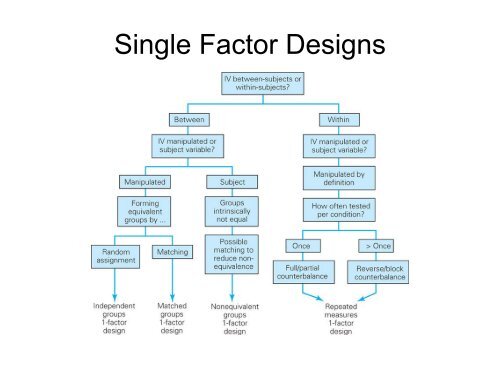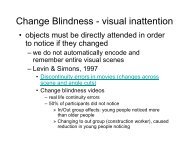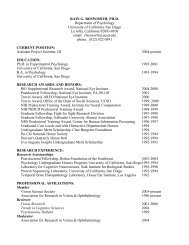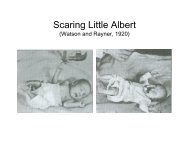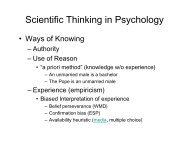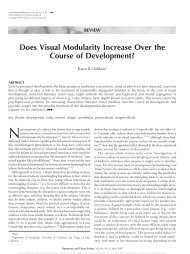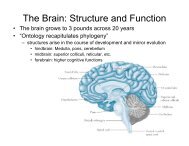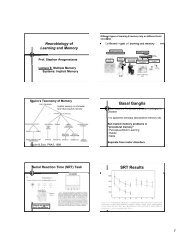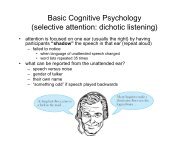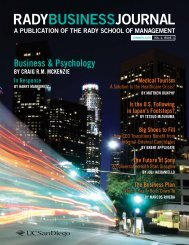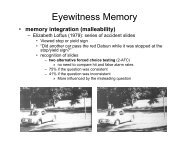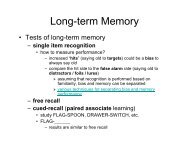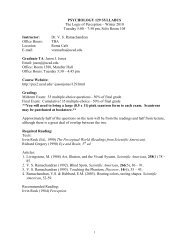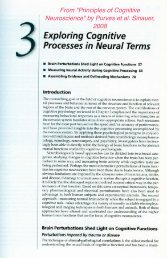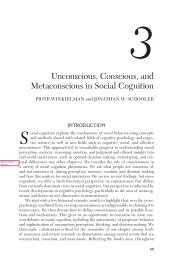Single Factor Designs
Single Factor Designs
Single Factor Designs
Create successful ePaper yourself
Turn your PDF publications into a flip-book with our unique Google optimized e-Paper software.
<strong>Single</strong> <strong>Factor</strong> <strong>Designs</strong>
Between-Subjects Between Subjects, Two Levels<br />
• Independent Groups<br />
– random a do assg assignment, e t, many a y pa participants tcpa ts<br />
– e.g., typical experiments in social Psychology<br />
– independent groups t-test<br />
• Matched Groups<br />
– smaller number of participants<br />
– some factor strongly correlates with DV<br />
– e.g., sleep deprivation and suggestibility study<br />
– with one-to-one matching, use dependent groups t-test<br />
• Nonequivalent groups<br />
– subject variable<br />
– match the groups on other characteristics<br />
• bbut t not t necessarily il a one-to-one t matching thi<br />
– e.g., neuropsychology
Within-subjects, Two Levels<br />
• once per condition, use complete counterbalancing<br />
• twice per condition, use reverse counterbalancing<br />
– e.g., Stroop (1935)<br />
• more than twice, use block randomization<br />
– sometimes can use alternation (Lee and Aronson, 1974)
• <strong>Single</strong> <strong>Factor</strong>, Multi-level<br />
– Discover non-linear effects<br />
• Ebbinghaus percent savings<br />
• u-shaped u shaped dose curve<br />
– multiple control conditions<br />
• Mozart effect<br />
– multiple control groups<br />
• Bransford and Johnson (1972)
If the balloons popped, the sounds<br />
wouldn’t be able to carry since<br />
everything would be too far away<br />
ffrom the th correct t floor. fl A closed l d<br />
window would also prevent the<br />
sound from carrying, since most<br />
buildings tend to be well insulated insulated.<br />
Since the whole operation depends<br />
on a steady flow of electricity, a<br />
break in the middle of the wire<br />
would also cause problems. Of<br />
course, the fellow could shout, but<br />
the human voice is not loud enough<br />
to carry that far. far An additional<br />
problem is that the string could<br />
break on the instrument. Then<br />
there could be no accompaniment<br />
to the message. It is clear that the<br />
best situation would involve less<br />
distance. Then there would be<br />
fewer potential problems. With<br />
face-to-face contact, the least<br />
number of things could go wrong.
• Presenting Data<br />
– In the text<br />
– Tables<br />
• Exact values<br />
– Graphs<br />
• IV on X, DV on Y
• Types of graphs<br />
– Line graphs (continuous IV -- interpolation)<br />
• More than 2 levels<br />
– Bar graphs (discrete IV -- categorical)<br />
• or continuous with just two levels (immediate versus 24 hours)<br />
– Scatter plots (correlation)<br />
– Error bars (whenever possible!)
Multiple Pairwise comparisons<br />
• If there are more than 2 conditions, you may<br />
want to make more than one simple comparison<br />
(more than one t test)<br />
• what’s the level for 3 conditions with 3<br />
comparisons? What about J comparisons?<br />
• Wh What t about b t dependencies d d i bbetween t comparisons? i ?<br />
• Bonferroni inequality gives upper limit to observing one or<br />
more type I errors (≤J)
Control group designs<br />
– Placebo control groups<br />
– Waiting list control groups<br />
• can be combined with placebo p<br />
– Merikle and Skanes (1992)<br />
– Yoked control groups<br />
• Eye y Movement Reprocessing g and Desensitization<br />
– Dunn et al. (1996)
which test?<br />
Within Subjects Between Subjects<br />
matching<br />
2 levels 3 or more levels 2 levels 3 or more levels<br />
dependent<br />
Repeated independent<br />
independent<br />
groups<br />
measures groups<br />
groups<br />
tt-test test<br />
ANOVA tt-test test<br />
ANOVA
IVs (between, within, manipulated), DVs, design, scale (nominal,<br />
ordinal, interval, ratio), presentation (table, graph), analysis<br />
• College students in a cognitive mapping study are asked to use a<br />
direction finder to point accurately to three unseen locations that<br />
differ in distance form the laboratory laboratory. One is a nearby campus<br />
location, one is a nearby city, and the third is a distant city.<br />
• Three groups of preschoolers (50 per group, assigned randomly) are<br />
iin a study t d of f ttask k perseverance in i which hi h ddelay l of f reward d is i varied. i d<br />
The children in all three groups are given a difficult puzzle and told<br />
to work on it as along as they would like. One groups is told that<br />
they will receive a chocolate bar at the end of the session if they<br />
complete l t the th puzzle. l Th The second d group will ill get t a chocolate h l t bbar after ft<br />
20 minutes from the end of the session, and the third will get the<br />
chocolate after 40 minutes.<br />
• To examine whether crowding affects problem-solving performance,<br />
participants are placed in either a large or a small room while<br />
attempting to solve a set of word puzzles. Before assigning<br />
participants to the two conditions conditions, the researcher takes a measure of<br />
their verbal intelligence to ensure that the average verbal IQ of the<br />
groups is equivalent.


